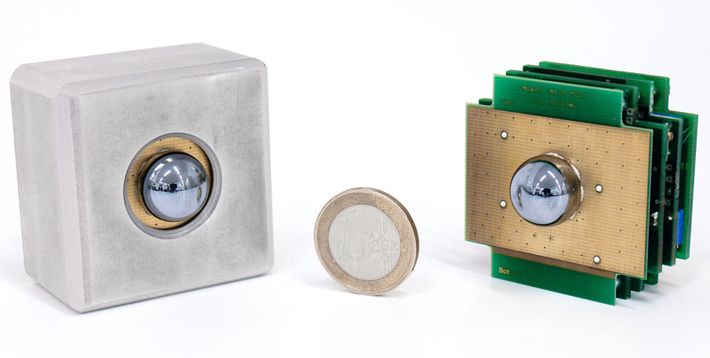A Cheap Terahertz Camera

17 April 2012—In the entire electromagnetic spectrum, one of the most conspicuously inaccessible chunks sits smack dab between radio waves and infrared light. Researchers have been trying for decades to come up with better ways to exploit the little-used terahertz band, which could provide ways to find hidden objects and determine an object’s chemical makeup at a distance.
Now a team from IEMN and STMicroelectronics, in France, and the University of Wuppertal, in Germany, has come up with a practical first: a video-rate CMOS camera that’s sensitive to terahertz frequencies.
“I think it’s the hottest thing in terahertz technology at the moment,” says Peter Siegel, who works on terahertz imaging at Caltech and NASA’s Jet Propulsion Laboratory and is not affiliated with the team. “They’ve done a remarkable job of solving a bunch of very pesky problems in working with silicon at high frequencies.”
Up until now, terahertz detectors have tended to be pricey affairs, composed of devices like Schottky diodes or microbolometers. A Schottky diode–based detector usually contains just one or a few pixels, which are raster-scanned across a scene to slowly form an image. Microbolometers can be arranged in arrays, but they must be cooled to boost their sensitivity.
With just 1024 pixels, this new transistor-based camera is unlikely to give a high-resolution window into the unseen terahertz realm. But the advance has researchers excited, because it suggests terahertz technologies may soon get a lot cheaper and more accessible. The single-pixel terahertz detectors in use now can easily cost as much as US $10 000, Siegel says, so developing a detector that could be mass-produced by chip manufacturers represents a significant advance. “I think you’re going to find a lot of applications opening up that didn’t exist before,” Siegel says.
Building terahertz detectors out of silicon is difficult, because even the best transistors don’t operate well at frequencies in excess of a few hundred gigahertz, the lower edge of the terahertz band. This limitation stems mainly from how fast electrons can shoot from one side of the transistor to the other, resulting in an intrinsic cutoff frequency above which a transistor can’t amplify signals sent into it. “Traditionally, people would say that beyond the cutoff frequency, the transistor wouldn’t work anymore,” says Hani Sherry, a doctoral candidate working at STMicroelectronics. But in 1996, device physicists Michel Dyakonov (now at the University of Montpellier, in France) and Michael Shur (of Rensselaer Polytechnic Institute, in Troy, N.Y.) argued in a paper that appeared in IEEE Transactions on Electron Devices that the cutoff frequency can be surpassed. Although they will not be able to amplify signals, some types of field-effect transistors can still respond to frequencies above the cutoff frequency due to electromagnetic oscillations within the transistor’s channel. (The channel is the main body of a transistor through which current flows when the transistor is on. It runs between two electrodes—the source and the drain—and is adjacent to a third, the transistor’s gate.)

A Cheap Terahertz Camera

